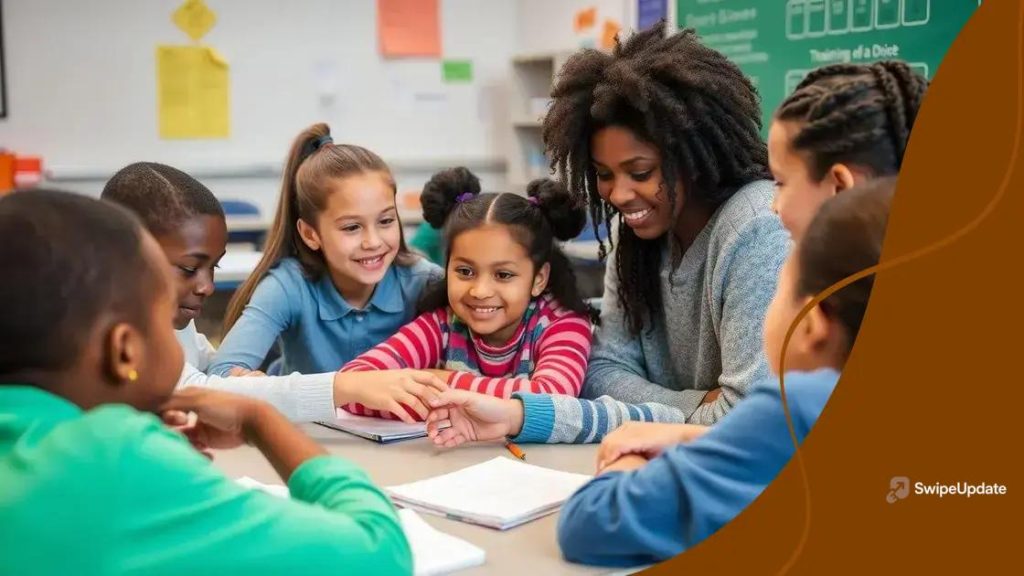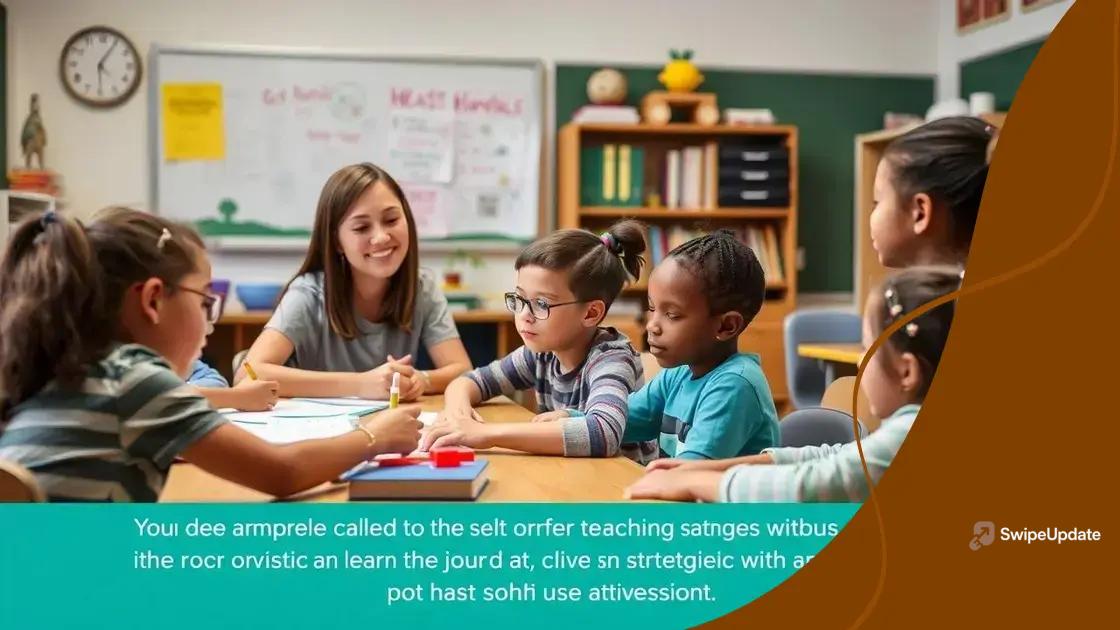Supporting students with disabilities: strategies for success

Supporting students with disabilities requires collaboration among educators, parents, and specialists, alongside effective teaching strategies and the use of technology to create an inclusive learning environment.
Supporting students with disabilities is crucial for fostering an inclusive education system. Have you ever wondered how tailored strategies can make a difference in their academic journey? Let’s explore some impactful approaches together.
Understanding the unique needs of students with disabilities
Understanding the unique needs of students with disabilities is essential for fostering an inclusive education. Each student comes with their own set of challenges and strengths, impacting how they learn and interact. With the right support, students can thrive academically and socially.
Identifying Diverse Needs
Every student with disabilities has different requirements that go beyond their diagnosis. Recognizing their individual strengths and challenges is key to providing appropriate support. Teachers can use assessments and observations to understand these needs better.
Additionally, forming strong relationships with students can help educators gain insights that standardized tests may not capture. Listening to students’ voices, respecting their preferences, and understanding their emotions can create a supportive learning environment.
Adapting Teaching Methods
To effectively support students, teachers need to adapt their teaching methods. Here are some strategies that can be beneficial:
- Use of visual aids and hands-on activities to enhance understanding.
- Provide additional time for assignments or tests.
- Incorporate flexible grouping to encourage collaboration.
- Use technology assistive devices tailored to students’ needs.
By personalizing instruction and allowing for flexible learning options, students can engage more deeply with the material.
Supporting students with disabilities also involves creating a positive classroom atmosphere. Encouraging peer support and fostering a culture of empathy can aid in building strong social skills. Emphasizing the importance of diversity and inclusion can help all students feel valued and respected.
Teachers should also collaborate with parents and specialists when necessary. By working together, they can create a comprehensive support system that addresses each student’s unique needs. Regular communication between school and home is vital for monitoring progress and making necessary adjustments.
Creating an inclusive classroom environment
Creating an inclusive classroom environment is vital for every student’s success. An inclusive space acknowledges and values diversity, allowing all students, including those with disabilities, to feel safe and empowered to learn. When students feel accepted, they are more likely to participate actively and express themselves.
Designing Physical Spaces
The physical layout of the classroom can significantly impact inclusivity. Here are some ways to create an inviting atmosphere:
- Arrange desks in a way that promotes group work and interaction.
- Ensure pathways are clear for students using mobility aids.
- Use flexible seating options to accommodate various needs and preferences.
Incorporating sensory-friendly elements, like noise-reducing panels or comfortable seating, can also enhance the learning experience for students with sensory sensitivities.
Fostering a Positive Culture
Encouraging a culture of respect and understanding is essential. Educators should model positive behaviors and establish clear expectations for how students should treat one another. Celebrating differences can bring the classroom community together.
Group activities that promote teamwork and collaboration help students build relationships while learning from each other. By implementing cooperative learning strategies, students of all abilities can contribute their unique perspectives.
Moreover, incorporating social-emotional learning (SEL) into daily activities can assist in managing emotions and developing empathy among peers. Techniques such as role-playing, storytelling, and group discussions can nurture these skills effectively.
Creating an inclusive classroom environment requires continuous effort from educators, students, and families. Partnerships with parents can ensure that everyone is on the same page regarding support and expectations, helping to create a cohesive experience for students.
Effective teaching strategies for diverse learners

Effective teaching strategies for diverse learners are essential in meeting the needs of all students, especially those with disabilities. By employing these strategies, teachers can create a dynamic learning environment where every student can succeed.
Differentiated Instruction
Differentiated instruction allows teachers to tailor lessons to meet the varied learning styles of their students. This approach recognizes that students learn in different ways and need different kinds of support.
- Modify content by providing various formats such as videos, texts, and interactive activities.
- Adjust the process by offering varied levels of tasks that challenge each student appropriately.
- Assess understanding in multiple forms, such as quizzes, presentations, or creative projects.
By differentiating instruction, teachers can engage every learner effectively, offering them a chance to shine in areas where they excel.
Universal Design for Learning (UDL)
Universal Design for Learning (UDL) is another approach that promotes inclusivity. UDL ensures that all learners have equal opportunities to learn by providing multiple means of engagement, representation, and action.
For instance, using flexible goals and options for how students demonstrate their knowledge can empower them to take ownership of their learning. This might include choosing between a written report or a video presentation, allowing learners to leverage their strengths.
Moreover, incorporating technology that supports learning can enhance the educational experience, making instruction more accessible. Tools such as text-to-speech, interactive apps, and assistive devices can cater to specific learner needs.
Promoting a growth mindset is also crucial. Encouraging students to embrace challenges, learn from mistakes, and believe in their potential leads to greater resilience and success.
Incorporating these effective teaching strategies creates an environment where all students can thrive. By adjusting methods and being flexible, educators can foster an engaging classroom that values diversity.
Collaboration with parents and specialists
Collaboration with parents and specialists is essential for supporting students with disabilities. When schools and families work together, they can create a comprehensive approach to meet each student’s unique needs. This teamwork fosters a strong support system that helps students thrive academically and socially.
Building Strong Relationships
Establishing open lines of communication is vital. Teachers should reach out to parents to understand their concerns, hopes, and insights about their child. Regular updates on student progress and classroom activities can help parents feel more involved.
Additionally, hosting meetings and workshops can provide parents with valuable resources and strategies to support their child’s learning at home. Listening to parents’ perspectives can bridge gaps between home and school experiences.
Involving Specialists
Integrating specialists, such as speech-language pathologists, occupational therapists, and counselors, into the educational process can make a significant difference. These professionals can assess students’ needs and contribute tailored strategies to enhance learning.
- Specialists can offer training to teachers on specific strategies for supporting diverse learners.
- They can also help develop Individualized Education Programs (IEPs) that genuinely reflect each student’s strengths and challenges.
- Regular collaboration meetings can ensure that everyone is aligned and that students receive consistent support.
Fostering a team approach ensures that parents, teachers, and specialists work together toward common goals. This shared commitment enhances the educational experience for students with disabilities.
Furthermore, encouraging parental involvement in decision-making processes can empower families and promote advocacy for their children. Parents who feel valued are more likely to engage actively, leading to better outcomes for students.
Utilizing technology to support learning
Utilizing technology to support learning can significantly enhance the educational experience for students with disabilities. By integrating various tools and resources, teachers can create a more engaging and inclusive classroom environment.
Assistive Technologies
Assistive technology refers to devices and software designed to help individuals with disabilities perform tasks that might be difficult for them. These tools can be vital for supporting students in their learning journeys.
- Screen readers enable visually impaired students to access written materials by converting text to speech.
- Speech-to-text software helps students who struggle with writing express their thoughts verbally.
- Text-to-speech tools can assist students in reading books or articles independently.
Incorporating these technologies allows students to overcome barriers and participate more fully in classroom activities.
Interactive Learning Platforms
Interactive learning platforms provide a dynamic way for students to engage with the curriculum. Many of these platforms offer adaptive learning experiences that adjust to each student’s pace and skill level.
For example, students can work on personalized learning paths that concentrate on their strengths and address their weaknesses. This adaptive approach helps every learner achieve their potential.
Moreover, gamified learning applications can motivate students through interactive challenges and rewards. These elements increase student engagement and reinforce learning in fun, creative ways.
Utilizing technology to support learning also involves using video conferencing tools for remote or hybrid learning situations. This ensures that all students have access to instruction, whether they are in the classroom or learning from home.
Overall, technology serves as a bridge for students with disabilities, opening doors to new learning opportunities and helping them achieve greater independence.
FAQ – Questions Frequently Asked About Supporting Students with Disabilities
What are some effective strategies for supporting students with disabilities in the classroom?
Effective strategies include differentiated instruction, utilizing assistive technologies, and fostering collaboration with parents and specialists.
How can technology assist students with disabilities?
Technology can provide tools like speech-to-text software and interactive learning platforms, enabling personalized learning experiences.
Why is collaboration with parents important for students with disabilities?
Collaboration helps ensure consistent support between home and school, empowering parents to advocate for their child’s needs.
What role do specialists play in supporting students with disabilities?
Specialists assess students’ needs, provide tailored strategies, and help develop Individualized Education Programs (IEPs) for effective learning.
